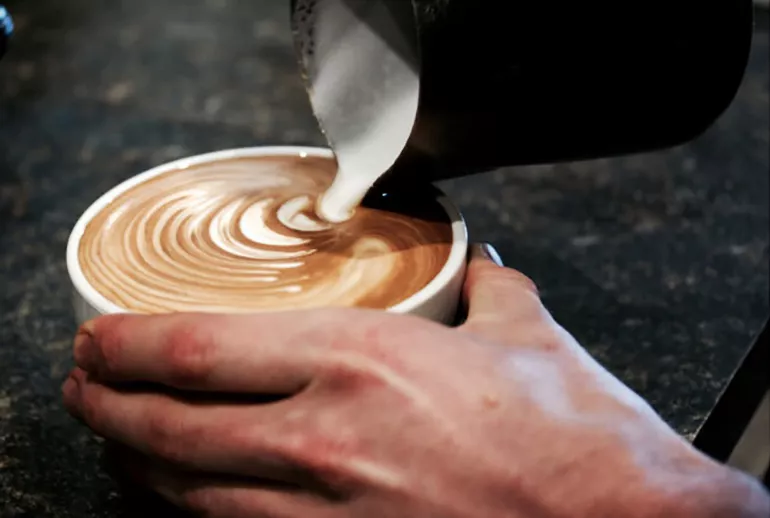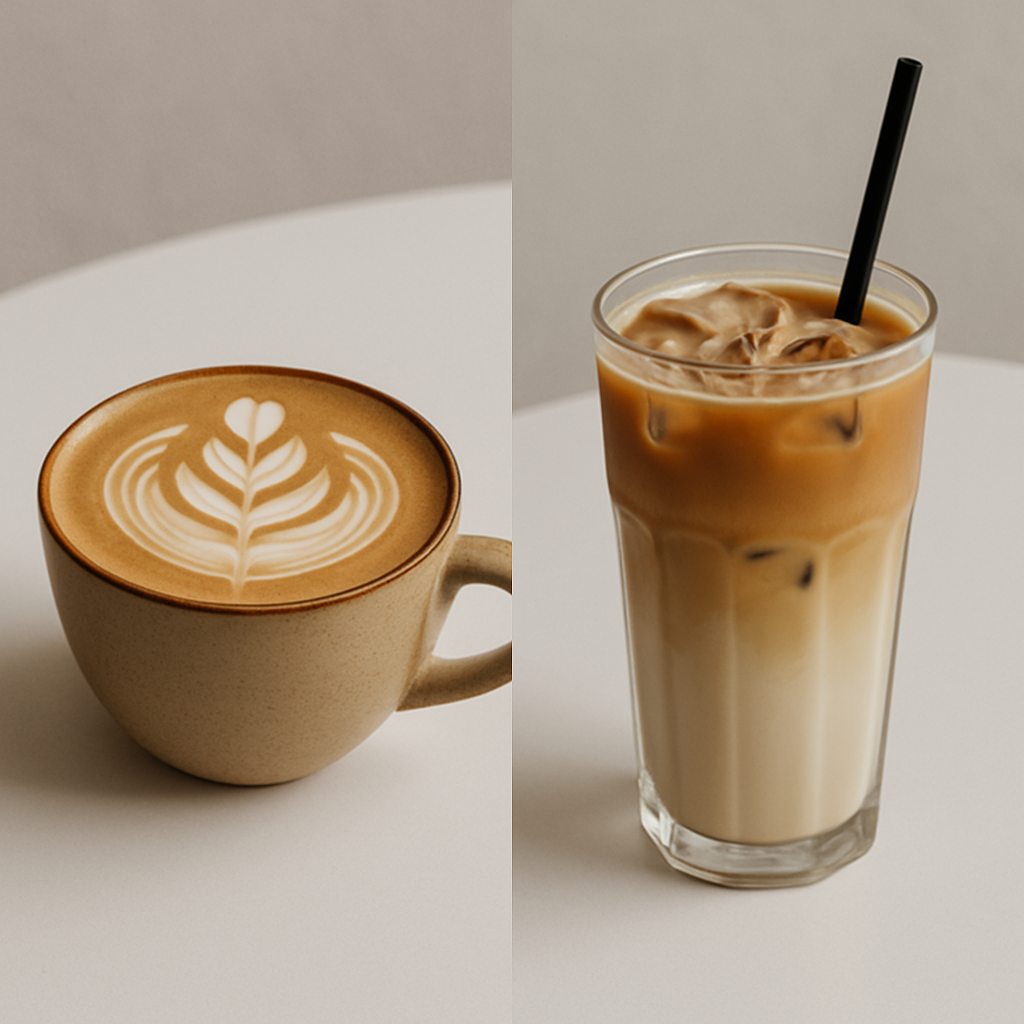Are Lattes Hot or Cold?
☕ The Confused Customer

Samantha stood in line at her local café, scrolling through her phone, when she heard the barista ask the man ahead of her, “Hot or iced?”
“Wait, what?” the customer hesitated. “I just ordered a latte.”
The barista smiled. “Yeah, lattes can be hot or iced. Your call.”
Samantha raised an eyebrow. She’d always thought lattes were hot by default. Was that true? Were iced lattes just a trend? What exactly was the proper form of a latte?
Welcome to the world of lattes—where tradition and modernity blend like milk and espresso.
Let’s settle the question once and for all: Are lattes hot or cold?
What Exactly Is a Latte?
Before diving into temperatures, we need to define what a latte is.
The word “latte” comes from the Italian “caffè latte”, which means “milk coffee.” Traditionally, it refers to a hot drink made with:
-
1 part espresso
-
2–3 parts steamed milk
-
A light layer of milk foam
It’s warm, creamy, comforting—and a morning ritual for many across Europe and North America.
But fast forward to modern cafés, and you’ll see the word “latte” next to images of tall glasses filled with cold milk and ice cubes.
So what gives?
The Rise of the Iced Latte
While lattes began hot, they’ve evolved. The iced latte is a newer, but now extremely popular, twist. It typically includes:
-
Espresso
-
Cold milk
-
Ice
Sometimes, flavors like vanilla or caramel are added, and unlike hot lattes, iced versions skip the steamed milk and foam.
💡 Why iced lattes became popular:
-
Refreshing alternative to hot drinks in warm weather
-
Ideal for on-the-go lifestyles
-
Customizable and Instagram-friendly
In the U.S., iced coffee beverages now make up over 25% of total coffee orders, according to a 2023 report by the National Coffee Association. Among Gen Z and millennials, that number is even higher.
So… Are Lattes Hot or Cold?
✅ The Answer:
Lattes can be both hot and cold.
-
Hot Latte: Traditional form, with steamed milk and espresso, served warm.
-
Iced Latte: Modern variation with cold milk and espresso over ice.
They share the same base ingredients—espresso and milk—but differ in temperature, texture, and sometimes preparation.
It’s like asking, “Is soup always hot?” Some prefer it cold. Lattes work the same way.
Hot vs Iced Latte: What’s the Difference?
Let’s break it down in a simple chart:
| Feature | Hot Latte | Iced Latte |
|---|---|---|
| Temperature | ~150–160°F (steamed) | Cold, served over ice |
| Milk | Steamed + microfoam | Cold, unsteamed |
| Texture | Creamy, silky | Light, refreshing |
| Caffeine | Same (based on espresso used) | Same |
| Taste | Balanced, mellow | Lighter, bolder espresso notes |
| Common Add-ons | Syrups, spices | Flavored syrups, cold foam |
| Ideal Season | Fall/Winter | Spring/Summer |
The main difference lies in the mouthfeel and temperature experience, not the base flavor or caffeine content.
Which One Has More Caffeine?
Both versions usually contain one to two shots of espresso, meaning about 63–126 mg of caffeine, depending on the café or your preferences.
📊 Fun Fact:
-
A grande hot latte at Starbucks has 150 mg of caffeine.
-
A grande iced latte? Also 150 mg.
So if you’re looking for a caffeine fix, the difference is negligible. Temperature doesn’t dilute caffeine—ice might slightly reduce the strength if it melts too much, but you’re still getting a similar dose.
The Cultural Side of Lattes
In Italy, if you ask for a “latte,” you’ll get a glass of plain milk. You must ask for “caffè latte” to receive espresso with milk.
There, lattes are almost exclusively hot.
In contrast, American coffee culture has embraced iced lattes as a year-round option. Many U.S. cafes even report higher iced drink sales during winter months, simply because people love the flavor, portability, and aesthetic.
Customization Has Changed the Game
Today’s lattes are part of a highly personalized coffee experience. Coffee drinkers aren’t just asking, “Hot or iced?” They’re choosing:
-
Almond, oat, or coconut milk
-
Extra espresso shots
-
Flavored syrups like hazelnut or pumpkin spice
-
Toppings like whipped cream or cinnamon dust
-
Foam textures: steamed, cold, dry, or none at all
It’s a coffee revolution. And lattes—both hot and iced—are at its center.
Where Coffea Alchemy Comes In
At Coffea Alchemy, we know the magic of a perfect latte lies not just in temperature, but in balance. Whether you love the warming comfort of a hot latte on a rainy morning or the crisp chill of an iced latte by the pool, our guides help coffee lovers decode the art behind their favorite cup.
Because when you understand your drink, you can make every sip more intentional.
Which Latte Should You Choose?
Choose a hot latte if you:
-
Want a comforting, warm drink
-
Appreciate smooth, creamy textures
-
Enjoy coffee in colder weather
-
Prefer traditional espresso-based beverages
Choose an iced latte if you:
-
Crave something refreshing and light
-
Like the sharpness of espresso flavor
-
Want a customizable base for syrups
-
Live somewhere warm—or it’s summer
There’s no wrong choice. Just different vibes.
Latte Myths, Busted
🧪 Myth #1: Hot lattes are stronger than iced.
➡️ Truth: Both use the same espresso shots.
🧪 Myth #2: Iced lattes are just cold coffee.
➡️ Truth: They’re espresso-based, not brewed coffee.
🧪 Myth #3: Only hot lattes are “real” lattes.
➡️ Truth: Cold lattes are equally valid in modern coffee culture.
Conclusion
So, are lattes hot or cold? The answer is: both—and neither is more “real” than the other.
What matters is how the drink makes you feel. Whether you’re savoring foam art on a hot latte or swirling ice in a tall cup on a sunny afternoon, the latte is as versatile as the people who love it.
And in today’s coffee culture, versatility is everything.
Which one will you order next time: hot or iced?
Related Post
Our newsletter
Subscribe to our weekly newsletter & keep up with our latest recipes and organized workshops. You can unsubscribe at any time.

